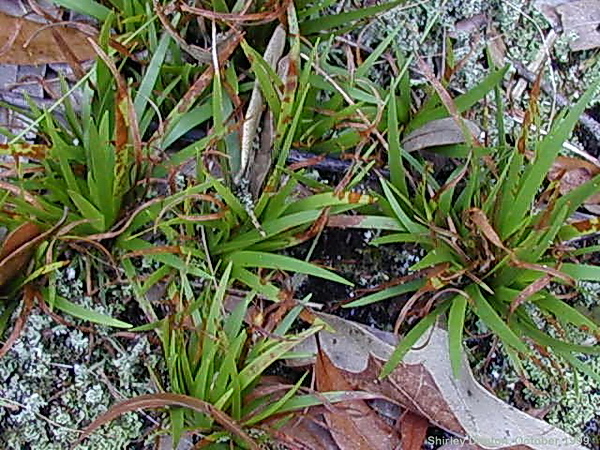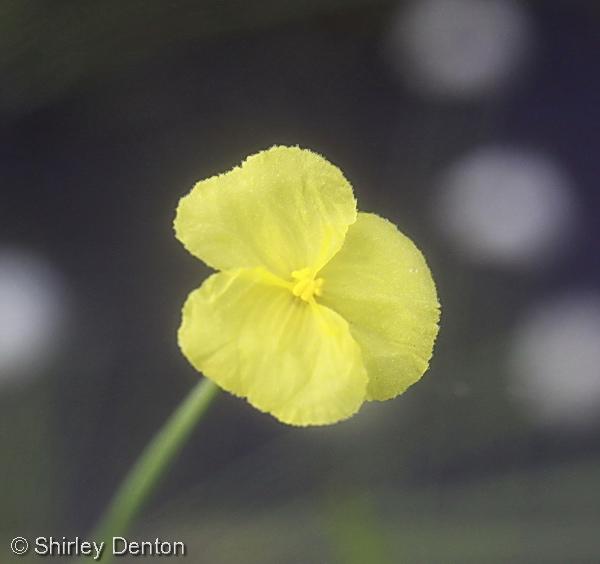Xyris brevifolia
| Xyris brevifolia | |
|---|---|

| |
| Photo by Shirley Denton (Copyrighted, use by photographer’s permission only), Nature Photography by Shirley Denton | |
| Scientific classification | |
| Kingdom: | Plantae |
| Division: | Magnoliophyta - Flowering plants |
| Class: | Liliopsida – Monocotyledons |
| Order: | Commelinales |
| Family: | Xyridaceae |
| Genus: | Xyris |
| Species: | X. brevifolia |
| Binomial name | |
| Xyris brevifolia Michx. | |

| |
| Natural range of Xyris brevifolia from USDA NRCS Plants Database. | |
Common name: Shortleaf yellow-eyed grass
Contents
Taxonomic notes
Description
A description of Xyris brevifolia is provided in The Flora of North America.
Distribution
Xyris brevifolia occurs in North Carolina, south to Florida, and westward to Mississippi. The distribution from Mississippi to Georgia and Florida, the species conservation status is not ranked/under review. In South Carolina, the species conservation status is critically imperiled. In North Carolina the species conservation status is vulnerable.[1]
Ecology
Habitat
In the Coastal Plain in Florida, Xyris brevifolia can occur in cypress depression swamps, coastal mesic flatwoods, wet pine flatwoods, river floodplains, Magnolia virginiana-Persea-Nyssa hammocks, exposed shores of karst ponds, cabbage palm hammock margins, tropical hammocks, coastal swales, and seepage bogs. It has occurred in disturbed areas such as roadside depressions and bulldozed clearing in pine-palmetto flatwoods. [2] Soils include Mandarin (Typic Haplohumods), loamy soil, loamy sand, sandy peat, and Newnan (Ultic Haplohumods). [2] Associated species include Pinus palustris, Aristida stricta, Serenoa repens, Ilex glabra, Xyris caroliniana, X. ambigua, Rhychospora plumosa, R. fernaldii, Lachnocaulon, Euphorbia telephiodes, and Drosera intermedia. [2] Occurs in pine-palmetto habitat in south Florida, occurrence is infrequent, and has no forage value.[3]
Phenology
Flowers and fruits February through October. [2]
Seed bank and germination
Xyris brevifolia was found in the seed bank of the wiregrass flatwood stands with multiple postfire ages, including as 3 years, 4, years, 11 years, 12 years, 13 years, 25 years, 29 years, and over 30 years post fire [4]. Xyris brevifolia seeds were found in the seed cores and in a vacuuming experiment in Florida’s flatwoods plant community, pre and postfire.[5]
Fire ecology
X. brevifolia has been observed growing in recently burned mesic pine flatwoods. [2]
Pollination
The following Hymenoptera families and species were observed visiting flowers of Xyris brevifolia at Archbold Biological Station: [6]
Halictidae: Lasioglossum pectoralis, L. tamiamensis
Megachilidae: Megachile brevis pseudobrevis
Conservation and management
Cultivation and restoration
Photo Gallery
Flower of Xyris brevifolia Photo by Shirley Denton (Copyrighted, use by photographer’s permission only), Nature Photography by Shirley Denton
References and notes
- ↑ [[1]] Nature Serve. Accessed: March 17, 2016.
- ↑ 2.0 2.1 2.2 2.3 2.4 Florida State University Robert K. Godfrey Herbarium database. URL: http://herbarium.bio.fsu.edu. Last accessed: November 2015. Collectors: Mary Atkinson, Loran C. Anderson, Edwin L. Bridges, George R. Cooley, A.H. Curtiss, Richard J. Eaton, Bob Fewster, Robert K. Godfrey, E.M. Hodgson, Richard D. Houk, Ann F. Johnson, Lisa Keppner, Mabel Kral, Robert Kral, O. Lakela, Sidney McDaniel, Marc Minno, Joseph Monachino, Steve L. Orzell, Paul O. Schallert, Cecil R. Slaughter, Robert F. Thorne, D.B. Ward, S.S. Ward. States and Counties: Florida: Alachua, Baker, Bay, Bradford, Citrus, Clay, Collier, Columbia, Dixie, Flagler, Franklin, Hamilton, Highlands, Hillsborough, Indian River, Lee, Leon, Levy, Liberty, Okeechobee, Osceola, Pinellas, Santa Rosa, Sarasota, Seminole, Sumter, Volusia, Wakulla, Walton, Washington. Compiled by Tall Timbers Research Station and Land Conservancy.
- ↑ Hilmon, J.B. (1964). “Plants of the Caloosa Experimental Range.” U.S. Forest Service Research Paper S E – 12.
- ↑ Maliakal, Satya K., Eric S. Menges, and J.S. Denslow (2000). “Community Composition and Regeneration of Lake Wales Ridge Wiregrass Flatwoods in Relation to Time-since-Fire.” The Journal of the Torrey Botanical Society Vol. 137, No. 2: 125-138.
- ↑ Kalmbacher, Rob; Cellinese, Nicoletta; Martin, Frank (2005). “Seeds Obtained by Vacuuming the Soil Surface after Fire Compared with Soil Seedbank in a Flatwoods Plant Community.” Native Plants Journal 6.3: 233-240.
- ↑ Deyrup, M.A. and N.D. 2015. Database of observations of Hymenoptera visitations to flowers of plants on Archbold Biological Station, Florida, USA.
